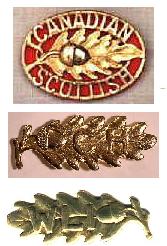Oak Leaf Shoulder Badge

When Battle Honours for the First World War were being considered in the 1920s, the units that perpetuated the 10th and 16th Battalions of the CEF were perturbed that they did not receive recognition for the Battle of Kitcheners Wood. That battle, on the night of 21-22 April 1915, had marked the first offensive action taken by Canadian soldiers in the First World War, and was later described by Marshall Foch as "the finest act in the War." The commanding officers of the three battalions (The Canadian Scottish, The Calgary Highlanders, and The Winnipeg Light Infantry) petitioned Ottawa, and gained the support of many prominent individuals such as Sir Arhur Currie. The Adjutant General proposed that a distinction in dress be awarded in lieu of a battle honour.
Several designs were discussed, taking as inspiration the legendary "Sphinx" appearing on British insignia commemorating service in Egypt, the back badge of the Gloucestershire Regiment, and other regimental distinctions. An oak leaf design was selected, as Kitcheners' Wood had been an oak plantation. Various collar and sleeve badges were proposed, and the final design was in the form of a metal shoulder title. General Orders in 1934 granted authority for the Calgary Highlanders and Canadian Scottish to wear bronze oak leaf and acorn badges with their names inscribed on an annulus. The WLI were to wear a badge consisting of the oak leaf and acorn with the initials on the regiment superimposed.
When the badges were presented in 1938, the Calgary Highlanders' design had again changed to one resembling the WLI, being a brass oakleaf with the letters CH superimposed. It is not clear why the change was made. The Canadian Scottish accepted the "soup plate" design with a large annulus surrounding the oak leaf. The Highlanders and WLI badges were mirrored, worn with the acorn facing the wearer's front, while the Canadian Scottish badge was identical for both shoulders. The Canadian Scottish Regiment was a two battalion organization before the Second World War and only the 1st Battalion was permitted the distinction.
When Battle Dress was adopted in 1939, metal shoulder titles were forbidden. The Canadian Scottish adopted a cloth shoulder flash in 1941 incorporating an oak leaf and acorn into the design, the Highlanders and WLI did not. On Service Dress, the metal badges continued to be worn, even after a mid-war order forbidding the wear of regimenal titles due to economy measures. When all officers overseas were ordered to wear the plain CANADA title instead of unit titles, the CO of the First Battalion, Canadian Scottish Regiment refused. He was told that he would be sent to Canada if he persisted, but he advised his officers to retain the prized oak leaf badges, and the matter was quietly dropped.
Oak leaves were again worn on Battle Dress after the Second World War. The introduction of new uniforms - notably Combat Dress and the post-Unification CF Uniform, posed a new threat. Metal insignia was not worn on the former, and the latter had no shoulder straps! The Canadian Scottish once again designed a cloth shoulder flash with oakleaf and acorn, as did the Calgary Highlanders. The WLI had been amalgamated into the Royal Winnpeg Rifles in 1955 and the tradition was not passed on in Winnipeg. N
Metal oak leaves continued to be worn on work dress, and with the introduction of the DEU, the metal titles in both regiments were once again worn with pride on service dress.